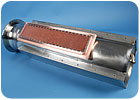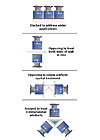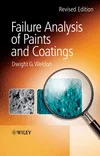EB Curing: The EB Advantage
The recent trends in global competition, rising and volatile energy costs, tightening emissions regulations and an overall drive for environmentally conscious manufacturing practices have led many finishing professionals to look for alternative curing technologies. The past several years have brought rapid changes in electron beam (EB) technology, making EB curing a more practical alternative to traditional curing methods.

Electron beam (EB) curing is one of the most powerful industrial curing technologies commercially available today. Historically relegated to niche applications, EB curing has long been recognized as an option for addressing the requirements of high-performance coating applications. The recent trends in global competition, rising and volatile energy costs, tightening emissions regulations and an overall drive for environmentally conscious manufacturing practices have led many converters, printers, industrial coaters and manufacturers to look for alternative curing technologies. The past several years have brought rapid changes in EB technology, making EB curing a more practical alternative to traditional curing technologies.

Although EB and UV are similar in many ways, EB-based processes offer several distinct advantages. UV-curable chemistries rely on a photoinitiator chemical to catalyze the polymerization process. When the photointiator is excited by a UV light, it releases the energy needed for the dilutant to react. EB curing systems deliver energy directly to the chemistry in the form of energetic electrons. EB-curable chemistries are nearly identical to UV-curable, but EB coatings do not require a photointiator. While UV curing is highly dependant on the efficiency of the photoinitiator, EB curing does not require any special additives or catalysts.
Additionally, unlike UV energy, which is concentrated on the surface, energetic electron energy has the ability to penetrate many materials (see Figure 1). Commercial “low energy” electron beams can deliver curing energy up to 200 microns (8 mils) beneath the surface of a coating layer. The ability to penetrate the surface in this manner enables a full through-cure for very thick coating layers and can deliver good substrate adhesion and a high-performance surface finish. EB energy absorption is not affected by the color of the coating or the substrate. Where UV energy can reflect off the surface, EB energy penetrates regardless of surface reflectivity.

Adoption of traditional EB curing systems has been limited by the size, cost and complexity of the technology. EB traditionally has been used with great success in wide web package printing and coating applications. While there have been some early adopters of EB curing in industrial wood, metal and plastic coating applications, the complexity and cost of inline EB curing integration often have outweighed the potential benefits. This cost-benefit analysis is now changing. With rising energy costs and tighter VOC emissions standards, the benefits of energy-curable technologies increasingly are becoming attractive to a wider range of manufacturers. Additionally, the past several years have brought the introduction of smaller, more cost-effective EB technologies. Together, these trends have allowed electron beam curing to be a more commonly considered alternative to traditional thermal curing or UV curing technologies.

In contrast to traditional wide web-based converting processes, modern EB curing technology increasingly is deployed in a widening array of applications, some of which are described below.
Narrow web printing. Small EB systems allow EB curing for narrow and mid web printing lines to be economically viable. EB curing of complex laminate structures, high-performance protective coatings, and printing with no- or low-photoinitiator inks are some of the potential applications of EB curing for narrow web printers.
Coil coating. EB curing of metal coil coatings offer an energy efficient and environmentally friendly alterative to traditional thermal cure systems. With this application, EB offers a distinct advantage over UV curing, which is less effective when curing the thick coatings used on the metal coil. EB curing can deliver substantial energy savings and productivity improvements, while also eliminating VOC emissions. The combination of these advantages typically justifies the cost of retrofitting an existing line within a short payback period.
Molded part coating. Arraying multiple electron beams along a conveyorized tunnel enables the curing of coatings for molded parts. Protective EB finishes can enhance appearance compared to traditionally cured coatings and improve scratch, chemical and thermal resistance properties.
Advanced opto-electronic applications. EB can provide a solution for many of the processing challenges in the emerging thin film solar and flexible display technologies. Complex film lamination, formation of cast microstructures and curing needs of protective coatings are examples of potential EB applications.
Hybrid UV/EB approaches. Because of the similarities in their chemistries, EB curing systems will cure a UV-curable coating. This fact can be leveraged when designing UV/EB hybrid curing lines. With these configurations, UV curing is used for surface curing in intermediate steps during the process. Since only a surface cure is required, it is possible to lower the power (and resulting heat) of the UV lights, use less photoinitiator and process at high line speeds. An EB curing system is then used for a final through-cure at the end of the line. The penetrating power of EB delivers good adhesion to the substrate, as well as a complete cure that allows for immediate in-line finishing tasks.
While EB curing has been around for decades, many of the applications discussed here are new. Like with any new technology, widespread adoption of EB takes time and requires the vision and foresight of industry leaders. While deploying EB curing in new ways might mean facing application development challenges, the potential payoff in energy savings, pollution reductions, productivity increases, and product differentiations make the projects strategic investments.
For more information about EB curing, visit www.aeb.com.

An electron beam emitter.
Electron beam (EB) curing is one of the most powerful industrial curing technologies commercially available today. Historically relegated to niche applications, EB curing has long been recognized as an option for addressing the requirements of high-performance coating applications. The recent trends in global competition, rising and volatile energy costs, tightening emissions regulations and an overall drive for environmentally conscious manufacturing practices have led many converters, printers, industrial coaters and manufacturers to look for alternative curing technologies. The past several years have brought rapid changes in EB technology, making EB curing a more practical alternative to traditional curing technologies.

EB Benefits
EB and ultraviolet (UV)-curable chemistries are based on similar reaction principles and typically are grouped together and referred to as “energy curable,” “radcure” or “100% solids” technologies. Traditional thermal-based technologies cure with an oxidation process that relies on evaporating a water-based or solvent-based dilutant, leaving the pigment or other functional additives bound in a resin matrix. As part of the curing process, 30 to 80% of the mass of a thermally cured part is evaporated off. Energy-curable chemistries cure by a polymerization process, in which a reactive dilutant is used to provide the viscosity needed to apply the coating. When energy is applied, the dilutant polymerizes or solidifies. Energy-curable chemistries do not lose any mass through evaporation. Manufacturers typically turn to UV- or EB-curable technologies for their lack of volatile organic compounds (VOCs), low energy consumption, low heat requirements, specialty finish effects and ability to be used on a variety of substrates.Although EB and UV are similar in many ways, EB-based processes offer several distinct advantages. UV-curable chemistries rely on a photoinitiator chemical to catalyze the polymerization process. When the photointiator is excited by a UV light, it releases the energy needed for the dilutant to react. EB curing systems deliver energy directly to the chemistry in the form of energetic electrons. EB-curable chemistries are nearly identical to UV-curable, but EB coatings do not require a photointiator. While UV curing is highly dependant on the efficiency of the photoinitiator, EB curing does not require any special additives or catalysts.
Additionally, unlike UV energy, which is concentrated on the surface, energetic electron energy has the ability to penetrate many materials (see Figure 1). Commercial “low energy” electron beams can deliver curing energy up to 200 microns (8 mils) beneath the surface of a coating layer. The ability to penetrate the surface in this manner enables a full through-cure for very thick coating layers and can deliver good substrate adhesion and a high-performance surface finish. EB energy absorption is not affected by the color of the coating or the substrate. Where UV energy can reflect off the surface, EB energy penetrates regardless of surface reflectivity.

Figure 2. A low-voltage electron beam emitter.
Expanded Appeal
Curing systems based on low-voltage electron beams have been in operation since the 1970s. Most EB technologies work by generating electrons thermionically, passing an electric current through a filament and then accelerating the electrons in a specific direction by applying a voltage potential between the “back” and the “front” of the device. The electrons are created within and accelerated through a vacuum chamber. The electrons pass out of the vacuum through a thin film typically made of titanium. This foil is generally referred to as the electron beam “window.” Electron beam generators used in curing applications are designed to create a “shower” or “curtain” of directed electron beam energy that can be used for industrial curing processes. Figure 2 illustrates the basic electron beam design. EB curing systems are composed of the electron beam, a vacuum pumping system to maintain the high level of vacuum, a power and control system, and a product transport and shielding system. Complete systems incorporating all of these elements sometimes are referred to as “self-shielded” EB curing systems.Adoption of traditional EB curing systems has been limited by the size, cost and complexity of the technology. EB traditionally has been used with great success in wide web package printing and coating applications. While there have been some early adopters of EB curing in industrial wood, metal and plastic coating applications, the complexity and cost of inline EB curing integration often have outweighed the potential benefits. This cost-benefit analysis is now changing. With rising energy costs and tighter VOC emissions standards, the benefits of energy-curable technologies increasingly are becoming attractive to a wider range of manufacturers. Additionally, the past several years have brought the introduction of smaller, more cost-effective EB technologies. Together, these trends have allowed electron beam curing to be a more commonly considered alternative to traditional thermal curing or UV curing technologies.

Figure 3. Various configurations of modular electron beam emitters.
A Cost-Effective Curing Solution
In recent years, suppliers of EB curing equipment have made strides in delivering small, low-energy curing systems. Advances in EB window technology, more efficient power systems and novel approaches to maintaining vacuum all have contributed to making EB curing systems more practical. One of the key benefits of smaller electron beams is the ability to integrate EB curing into a wider variety of material handling schemes. While traditional EB curing mostly was limited to wide web-based processing, modern electron beam systems can be configured to address many different product geometries, as shown in Figure 3. Compact EB designs can be integrated directly into a wide range of equipment. Furthermore, smaller, self-shielded EB curing systems can be retrofitted into existing thermal or UV cure lines.In contrast to traditional wide web-based converting processes, modern EB curing technology increasingly is deployed in a widening array of applications, some of which are described below.
Narrow web printing. Small EB systems allow EB curing for narrow and mid web printing lines to be economically viable. EB curing of complex laminate structures, high-performance protective coatings, and printing with no- or low-photoinitiator inks are some of the potential applications of EB curing for narrow web printers.
Coil coating. EB curing of metal coil coatings offer an energy efficient and environmentally friendly alterative to traditional thermal cure systems. With this application, EB offers a distinct advantage over UV curing, which is less effective when curing the thick coatings used on the metal coil. EB curing can deliver substantial energy savings and productivity improvements, while also eliminating VOC emissions. The combination of these advantages typically justifies the cost of retrofitting an existing line within a short payback period.
Molded part coating. Arraying multiple electron beams along a conveyorized tunnel enables the curing of coatings for molded parts. Protective EB finishes can enhance appearance compared to traditionally cured coatings and improve scratch, chemical and thermal resistance properties.
Advanced opto-electronic applications. EB can provide a solution for many of the processing challenges in the emerging thin film solar and flexible display technologies. Complex film lamination, formation of cast microstructures and curing needs of protective coatings are examples of potential EB applications.
Hybrid UV/EB approaches. Because of the similarities in their chemistries, EB curing systems will cure a UV-curable coating. This fact can be leveraged when designing UV/EB hybrid curing lines. With these configurations, UV curing is used for surface curing in intermediate steps during the process. Since only a surface cure is required, it is possible to lower the power (and resulting heat) of the UV lights, use less photoinitiator and process at high line speeds. An EB curing system is then used for a final through-cure at the end of the line. The penetrating power of EB delivers good adhesion to the substrate, as well as a complete cure that allows for immediate in-line finishing tasks.
While EB curing has been around for decades, many of the applications discussed here are new. Like with any new technology, widespread adoption of EB takes time and requires the vision and foresight of industry leaders. While deploying EB curing in new ways might mean facing application development challenges, the potential payoff in energy savings, pollution reductions, productivity increases, and product differentiations make the projects strategic investments.
For more information about EB curing, visit www.aeb.com.
Looking for a reprint of this article?
From high-res PDFs to custom plaques, order your copy today!









